March 29, 2015
Greyhound Lafayette to Chicago 930a – 1050a Bus
Amtrak Chicago to Portland 215p – 1010a +2 Empire Builder First Class
I spent a fun weekend visiting a fellow Denali driver and watching some exciting college basketball while enjoying fine food and drink to excess…
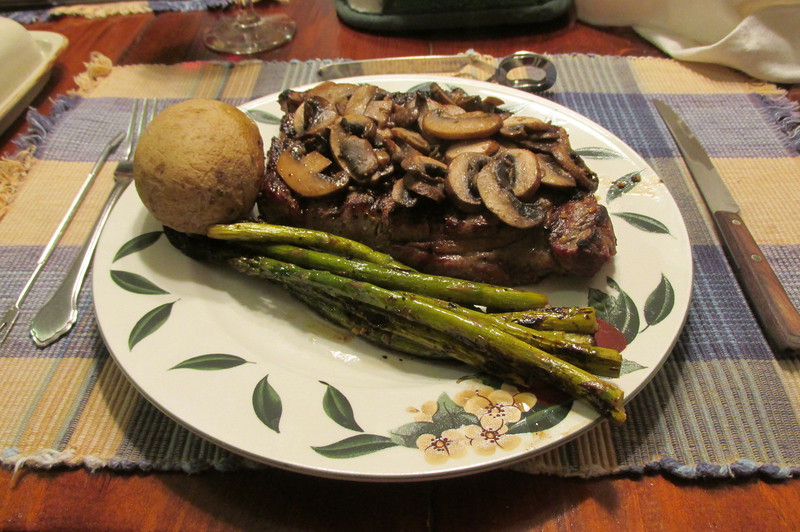 Fine Food
Fine Food
And
 An enviable selection of bourbons for one night
An enviable selection of bourbons for one night
It was now time to move on to the rail travel portion of this adventure. Over the next eleven days I will be riding seven trains over 10000 miles through nineteen states. I’ll spend nine nights onboard while enjoying twenty-three meals in the dining car. For a guy who likes to ride trains, I fully expect the next few days to be a lot of fun.
I suppose I could have started this trip aboard Amtrak’s
Hoosier State between Lafayette and Chicago but its 730am departure was a bit earlier than I like for vacation travel. Thankfully Greyhound offered a more leisurely 930am departure operating nonstop to downtown Chicago. At just $18.50 one way, the price was right and so it was that I was dropped off at 300 E. 2nd Ave. on a clear but chilly morning to board my shiny new Wi-Fi equipped motor coach for the two hour journey up to The Big City.
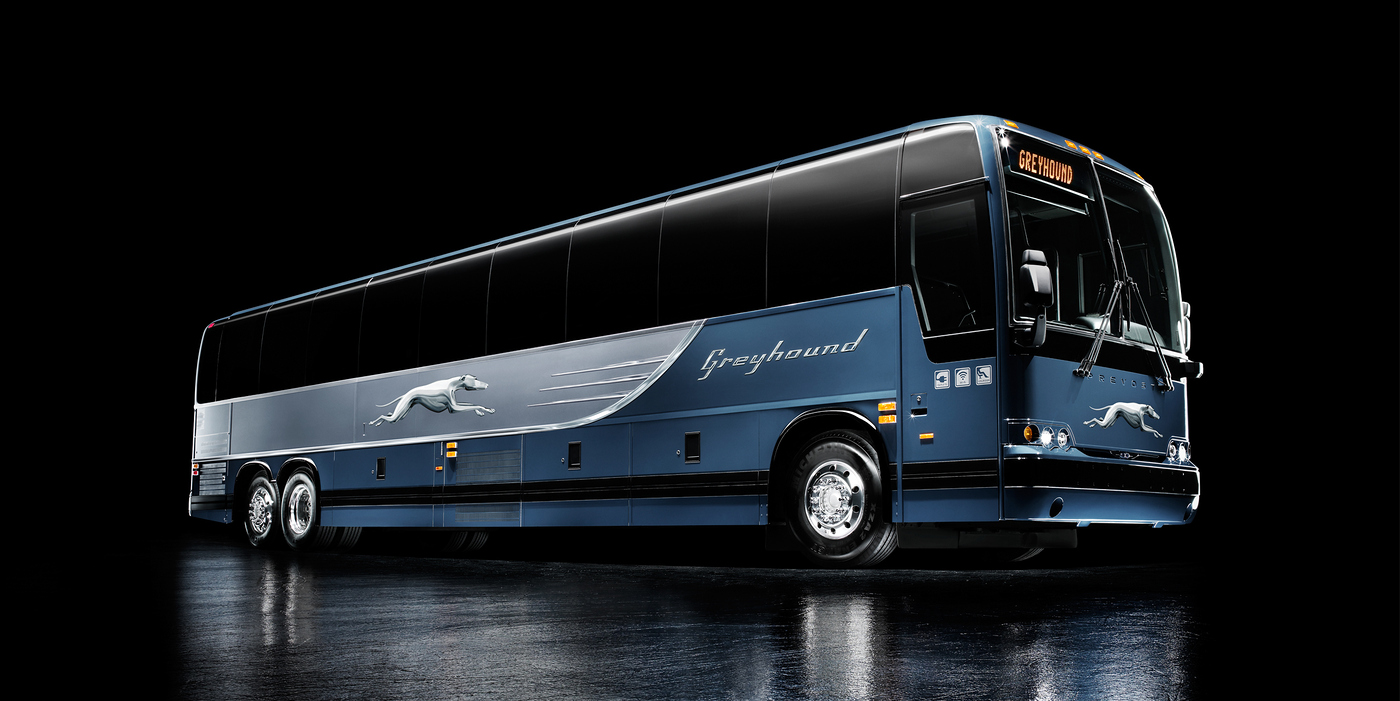 Greyhound’s New Dog
Greyhound’s New Dog
For many of us, a ride on the Grey Dog is tantamount to life’s having thrown us a curveball. To be sure, ridin’ the dog is usually the least expensive transport option and as such comes with the least amount of creature comforts. Unless you’re truly down on your luck, why would you not travel aboard something a bit faster or more comfortable?
It should be noted here that Greyhound is the largest provider of intercity bus transportation in North America, serving more than 3,800 destinations across the continent. Between many small to medium sized towns and cities it represents the only means of direct transport. In the case of Lafayette, Indiana to Chicago, Greyhound offers four daily departures to Amtrak’s one. Additionally, the express busses get up to Chicago an hour faster than the train with only a marginal drop off in comfort. My 930am departure was branded as Greyhound Express service and included free Wi-Fi, power outlets and extra legroom.
This is still Greyhound however, and unfortunately a significant number of its traditional clientele are still trying to come to grips with civilized behavior in a public setting. As such we were issued the usual warnings about alcohol and drug use onboard the bus as well as the requirement to use headphones when listening to music. Beyond that, it was a nice ride and we pulled into the Chicago Terminal ten minutes early. Way to go, Greyhound!
* * * _ * _ * * *
We’re going to commence this eleven day grand rail extravaganza with a 2,257 mile ride aboard Amtrak’s famous
Empire Builder. I think this is a great train to start out with if only because the
Empire Builder is the most popular long-distance train in the Amtrak system. It carries an average of about 500,000 riders per year from Chicago to the Pacific Northwest via Wisconsin, Minnesota, North Dakota, Montana and Idaho. The line splits at Spokane, Washington with half of the train continuing on across the Cascade Mountains to Seattle, Washington while the other half heads southwest down the Columbia River to Portland, Oregon.
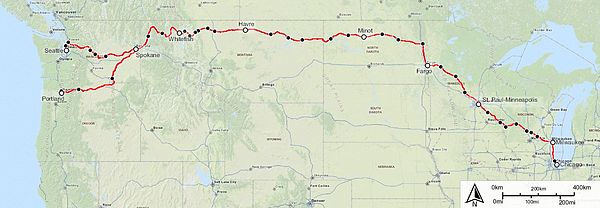 Route of The Empire Builder
Route of The Empire Builder
Chicago’s Union Station is massive, taking up approximately nine and a half city blocks. Built in the popular Beaux-Arts style seen in stations at Kansas City, St. Louis and Denver to name just a few, Union Station is known for its distinctive Corinthian columns and magnificent Great Hall. The station was recently designated as one of America’s “Great Places” by the American Planning Association and for those that have an hour or two between trains, it’s worth having a look around.
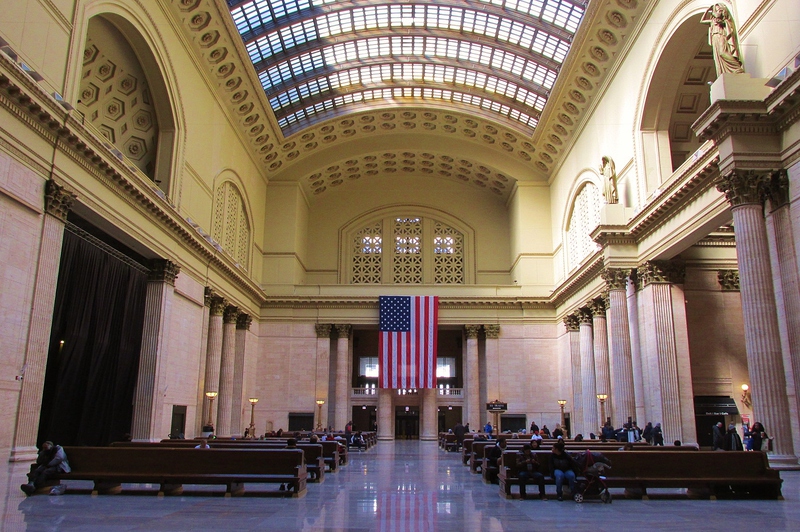 Chicago Union Station’s Great Hall
Chicago Union Station’s Great Hall
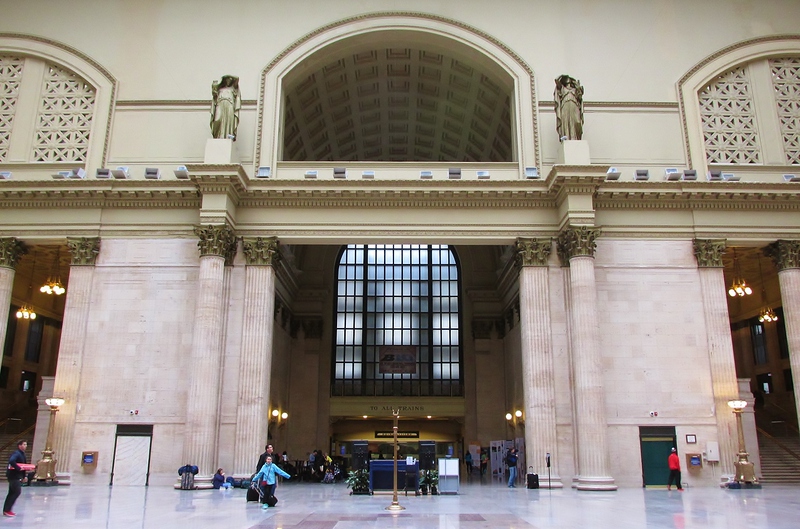 Passageway to trains flanked by grand stairways to street level
Passageway to trains flanked by grand stairways to street level
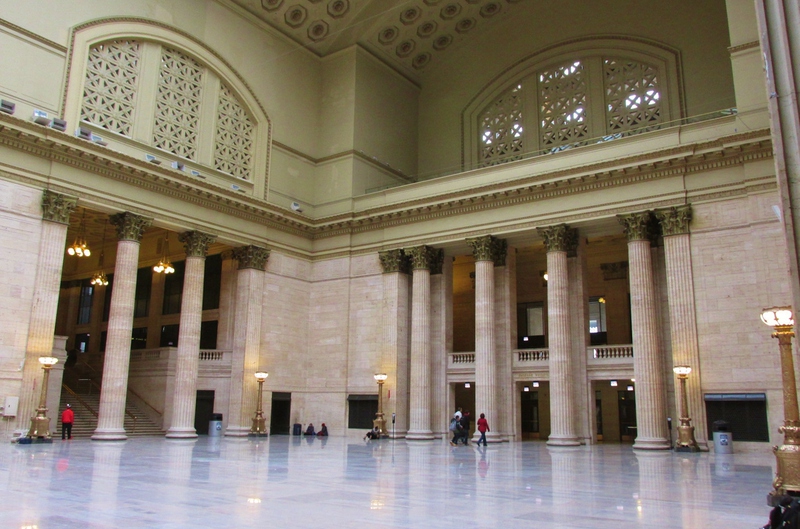 Distant corners of Chicago’s Union Station
Distant corners of Chicago’s Union Station
Passengers traveling in First Class sleeper accommodations have access to Amtrak’s Metropolitan Lounge. As lounges go, this one is nothing special. While it provides a quieter and more comfortable environment than that found out in the main gate lounges, amenities are limited to a baggage storage room and free Wi-Fi. The only refreshments available are coffee, soda, chips and sweet rolls (during the morning hours). Although it’ll never be confused with a proper airline lounge (even a U.S. airline lounge!) it does represent a considerable improvement over sitting out amongst the huddled masses in the crowded gate lounges.
 Reception desk and food service area of Amtrak’s Metropolitan Lounge
Reception desk and food service area of Amtrak’s Metropolitan Lounge
 Lounge seating in Amtrak’s Metropolitan Lounge
Lounge seating in Amtrak’s Metropolitan Lounge
While sat in the lounge, I overheard a man ask “What kind of name is “
Empire Builder” for a train?”
That’s a good question. Many train names suggest a speedy journey or they highlight the destination. Consider the
Silver Meteor, the
California Zephyr,
The City of New Orleans or the
Broadway Limited. Still others evoke the romantic ambience of travel such as the
Sunset Limited or the
Coast Starlight.
The
Empire Builder is named for James J. Hill, the president and founder of the Great Northern Railway. In the late 1800s Hill reorganized several failing railroads into the Great Northern and then extended the line to the Pacific Northwest. During his westward expansion he allowed immigrants (who had arrived mainly from Norway and Sweden) to travel across the country on his railroad for $10.00, with the stipulation that they agree to settle along the route. He even arranged for agriculture experts to teach them farming techniques applicable to the rough plains of North Dakota and Montana.
By encouraging the creation of settlements and towns along the Great Northern's route, Hill set the stage for the region's economic development in the production of agricultural and other products that his railroad would then carry to the rest of the country. In the process he became known as "
The Empire Builder". The train that honors him was inaugurated by the Great Northern in 1929 and quickly displaced the
Oriental Limited as the railroad's premier train.
* * * _ * _ * * *
Boarding for the
Empire Builder was announced at 1:45pm, one half hour prior to departure. To avoid crowding on the platform, First Class passengers are boarded a few minutes before those traveling in Coach. We all gathered at the rear of the lounge where a uniformed Amtrak employee led us out to the train. The train had been backed into the station and as a result I didn’t have far to walk since my sleeping car was the very last car.
While this seemed initially fortuitous, I later discovered that with the train’s construction being built around the split in Spokane, my car ended up being separated from the lounge by two cars and from the diner by five cars! Here’s how the consist worked out:
Leading the charge with a combined total of 9000 horsepower were two GE P42 "Genesis" Locomotives. Following them – in order – was:
Baggage car (Seattle)
Transitional Crew Sleeper (Seattle)
Sleeper (Seattle)
Sleeper (Seattle)
Diner (Seattle)
Coach (Seattle)
Coach (Seattle)
Sightseer Lounge/Café (Portland)
Coach/Baggage (Portland)
Coach (Portland)
Sleeper (Portland)
I’ve noted the destinations of both Seattle and Portland bound cars so that you can better appreciate how much smaller the train that continues on to Portland becomes. We’ll be all of just four cars with no diner. More on that later though...
Waiting at the entrance to my sleeper was my car attendant Ray, a twenty-seven year veteran of Amtrak’s onboard services. In his possession was a manifest bearing the names of all his expected passengers between Chicago and Portland. My name was quickly located and checked against my ticket, after which I was directed to my accommodation – Room 11 – located downstairs and to the left.
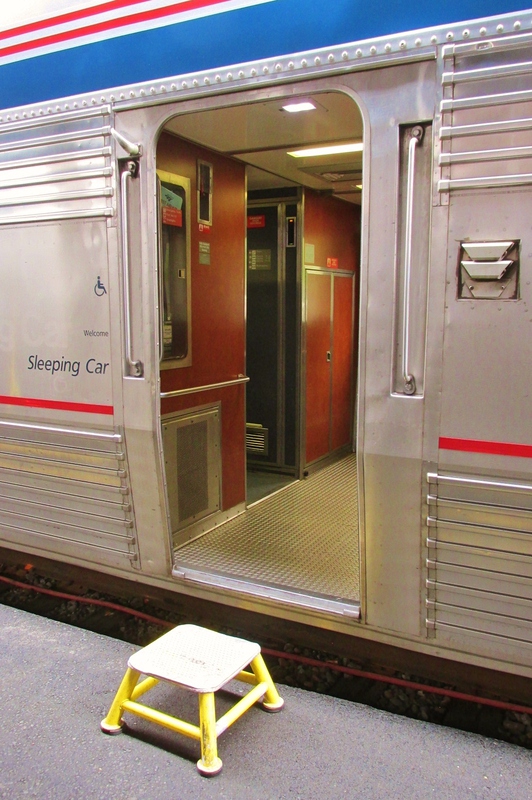 Your car and room await
Your car and room await
It should be noted here that each Amtrak bi-level Superliner Sleeper car offers 14 Roomettes, 5 Deluxe bedrooms, 1 Family bedroom and one Handicapped bedroom. Four roomettes along with the Family and Handicapped bedrooms are located downstairs. The roomettes measure 3’6” by 6’6” and are accessed via a sliding glass door. During the day they offer two wide opposite facing seats that fold together to become a bed at night. Above them is a fold-down upper berth. Other amenities include four separate lights, an electrical outlet, a tall mirror, a fold out table, a small open closet with hangers and a thermostat which I immediately turned to its lowest level. Best of all, each compartment has its own huge window, approximately 2½’ X 5’, through which to view the passing scenery. Toilet and shower facilities are down the hall. For a single traveler, I think these roomettes are quite sufficient and comfortable which is a good thing because they would be my home for the next four nights. At the top of the stairway is the service area for each car. In the morning, juice and coffee are available from this area.
Click
HERE for a virtual tour of Amtrak’s Superliner Roomette.
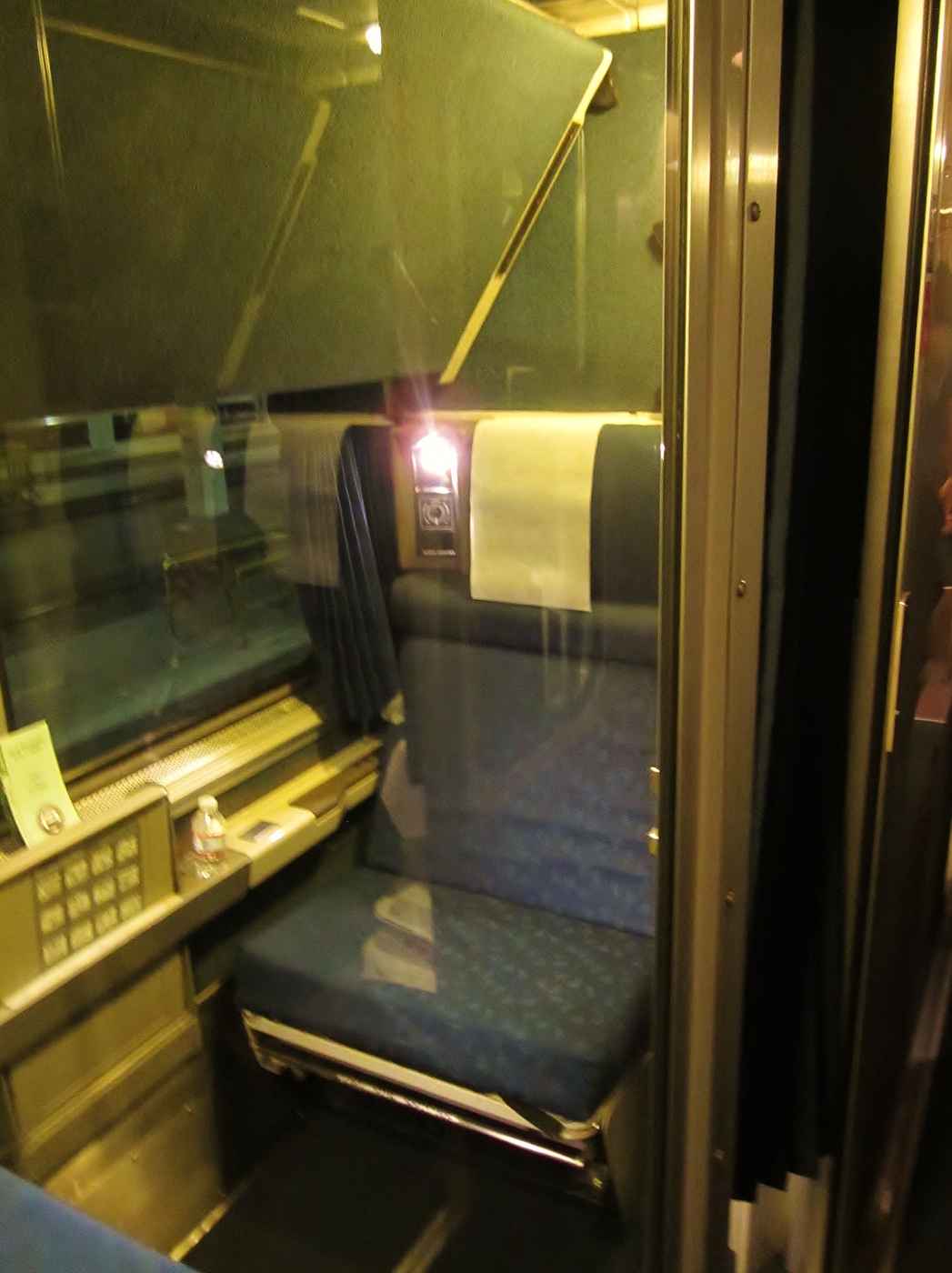 Amtrak Roomette Seat
Amtrak Roomette Seat
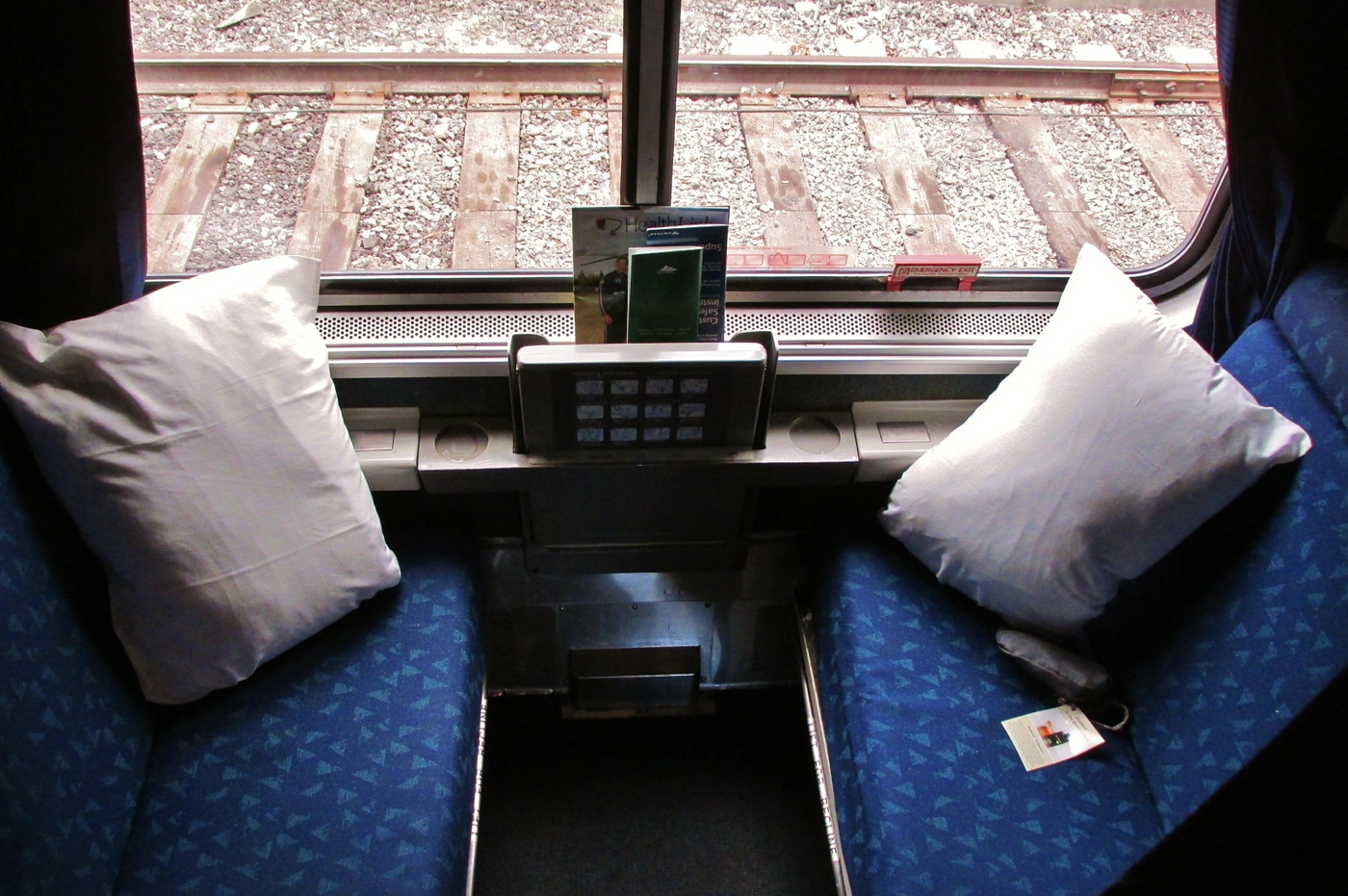 Amtrak Roomette Seats
The two seats lower and combine to create a 180° flat bed
Amtrak Roomette Seats
The two seats lower and combine to create a 180° flat bed
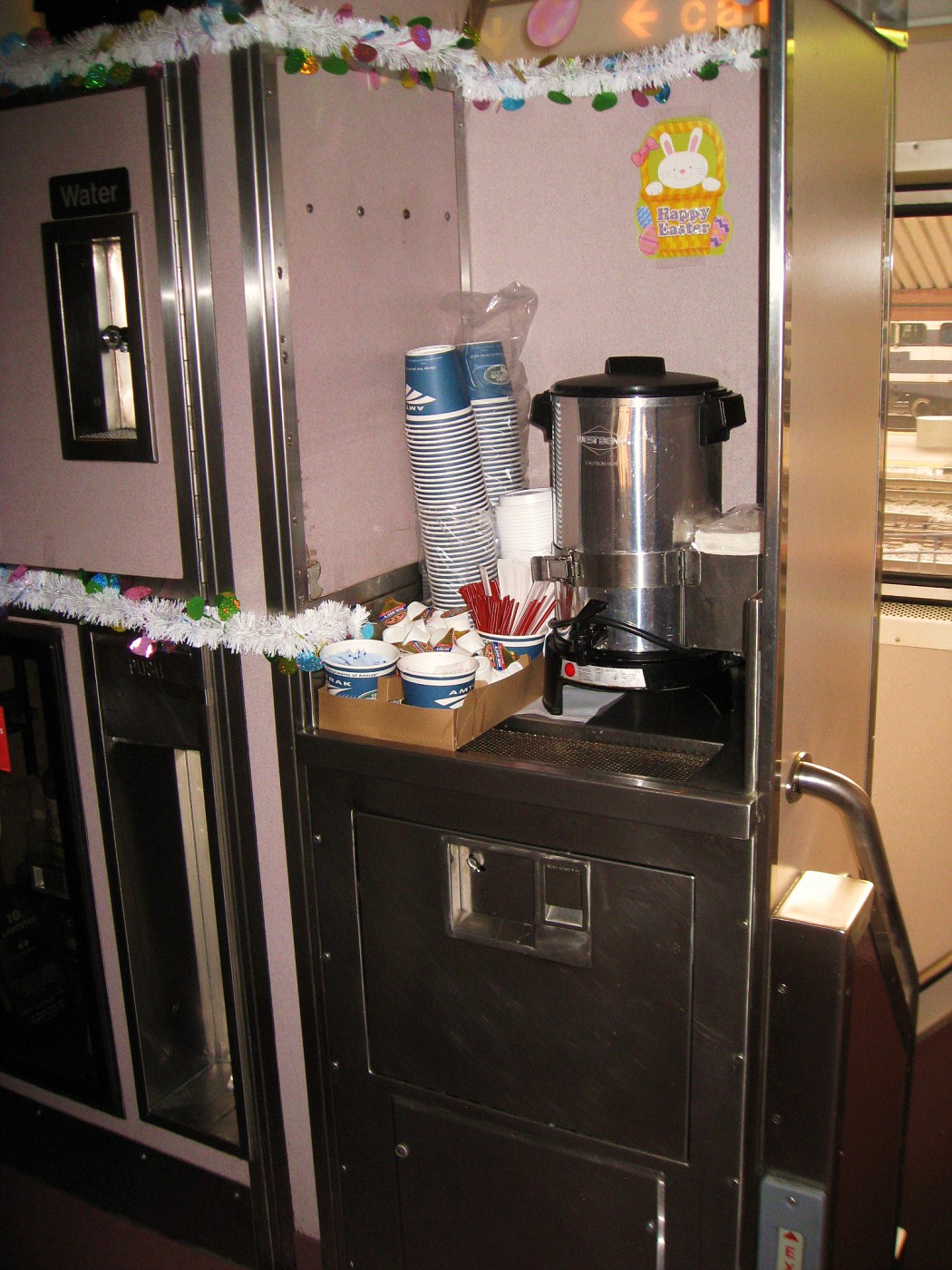 Superliner Service Area
Superliner Service Area
At my seat were two big fluffy pillows. On the center console where the table is stored were two bottles of water and a variety of pamphlets about the train. There was a route guide, a timetable, a safety card much like you’d see aboard an airliner and a brochure describing the train and its various services and attractions.
Although most people are excited about the prospect of a seat or bedroom high on the upper level of Amtrak’s Superliner fleet, I specifically choose a lower level room for two reasons. First, the downstairs rooms are quieter because there is much less foot traffic passing by your door. All the inter-car traffic is upstairs. As well, the train’s motion as it speeds down the tracks can occasionally make straight-line walking a challenge, causing some people to ricochet their way down the narrow hallways, bouncing off walls and doors with equal abandon. One sleeping car passenger complained that her arms were bruised after just one afternoon on the train. Secondly, riding in the lower level of the car results in much less tilt motion than is experienced on the upper levels. Like a fulcrum point on a seesaw, the ride is smoother the lower you are.
I hung my jacket and then grabbed my camera and stepped off the train for a couple of obligatory pre-trip photos. Train travel is exciting stuff with plenty of sights, sounds and smells to stimulate the senses. Boarding most airplanes these days has become a relatively sterile experience as you’re usually separated from your aircraft by large glass windows and a jet bridge. By comparison, you must walk up to and meet your train. It’s right there in front of you – big, silver and inviting of your inspection. Amtrak’s bi-level Superliner cars are especially large, towering above those of us down on the platform. Even at idle the big diesel locomotives are quite loud, emitting a variety of noises such as changes in rpms or the occasional short release of air.
The challenge for me is seeing if I can come up with photographs that might help you the reader better appreciate this trip as I experience it, but hopefully in an interesting way. Maybe I can catch that train car in an interesting light, like this:
 Premier Class Car at Johannesburg
Premier Class Car at Johannesburg
Unfortunately, the trackside lighting in the bowels of Chicago’s Union Station does not lend itself well to quality photography of train cars, much less anything else. This one, taken in an attempt to capture a bit of trackside ambience, didn’t turn out too badly though…
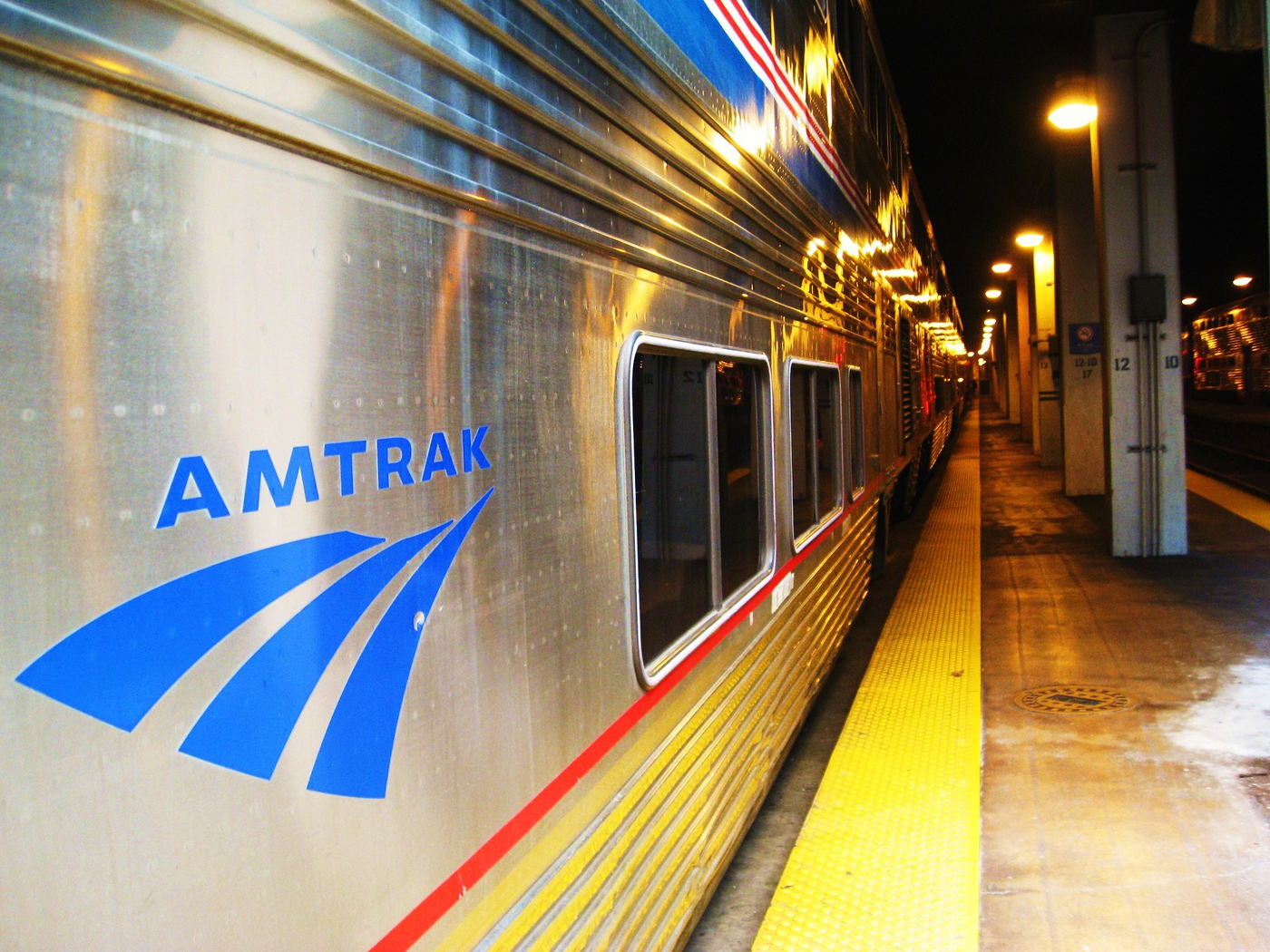 Welcome aboard Amtrak
Welcome aboard Amtrak
One thing I don’t feel a need to do is have you experience every little thing I see no matter how mundane. It’s selfish, really, but I generally only take pictures of things that I personally find interesting. That means I won’t be providing you with pictures of things like the fold out table in each room, the closet, the light and climate controls, the toilets or the baggage storage area located on the lower level of the car. I know that many fans of photo reports crave that level of detail but given all the time I invest in actually writing this report, I’d rather try to employ photos that better capture the more interesting or important things that I’m writing about.
Trying is the operative word here because I don’t know anything about photography. I’ve never taken a class and I have not the slightest idea what an F stop or an aperture is. I just point my little Canon SX-160 and press the button. Hopefully what my photos lack in quantity they’ll make up for in quality of composition.
Anyway, where were we? Ah yes, trackside at Union Station – primed and ready to commence this eleven day rail tour of the American west. This is so exciting! There’s the “All Aboard!” call - Let’s re-board now and settle in for the journey.
Upon departing Chicago's Union Station the
Empire Builder rolls north to Milwaukee, Wisconsin, then on through the rural landscape of southern Wisconsin, crossing the Upper Mississippi River at La Crosse. I spent most of this portion of the trip in the lounge car. Pretty afternoon lighting highlighted the pleasant farmland and rolling plains of Wisconsin. The beige and yellow landscape contrasted nicely with the stormy skies above…
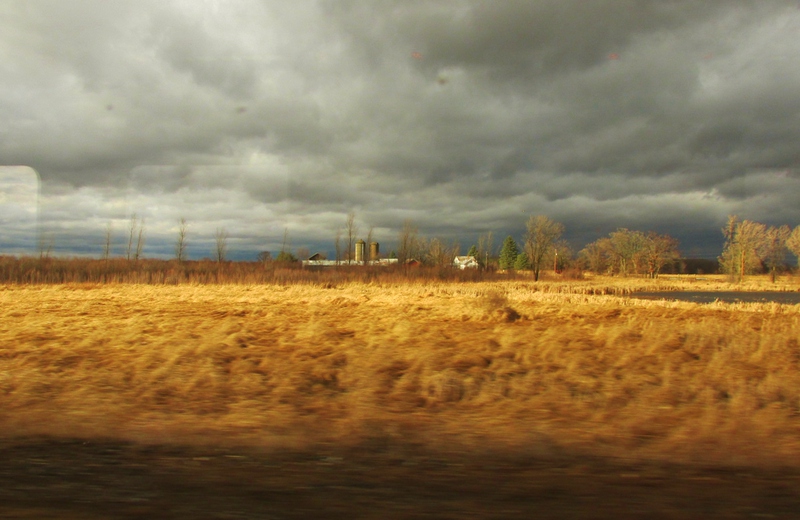 A pretty farm set against a stormy sky
A pretty farm set against a stormy sky
 Two girls kick back and enjoy the journey from the Sightseer Lounge
Two girls kick back and enjoy the journey from the Sightseer Lounge
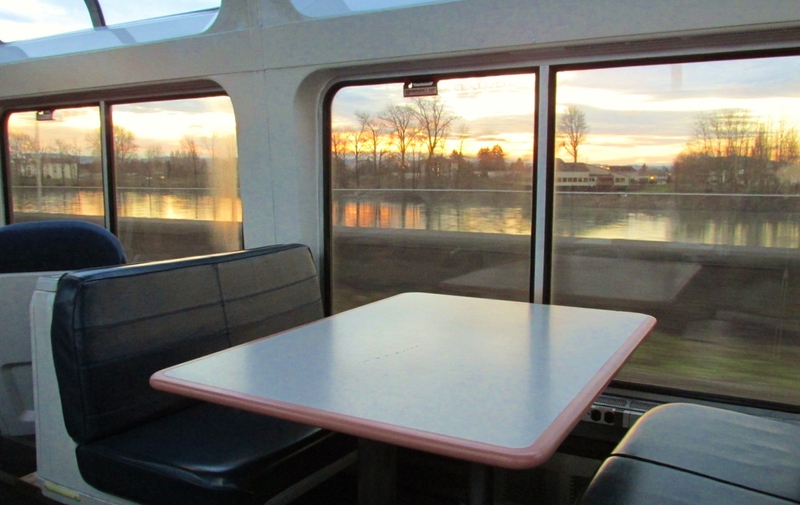 Early evening scenery
Early evening scenery
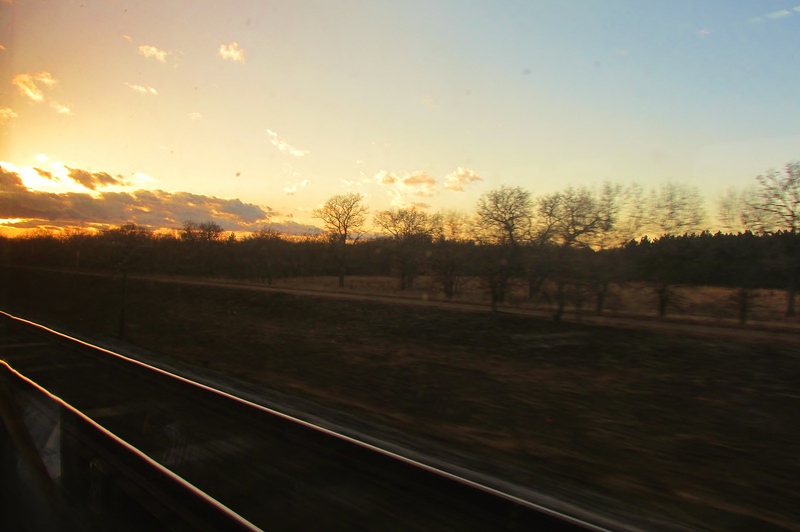 The sun sets as we speed west at 79 mph
The sun sets as we speed west at 79 mph
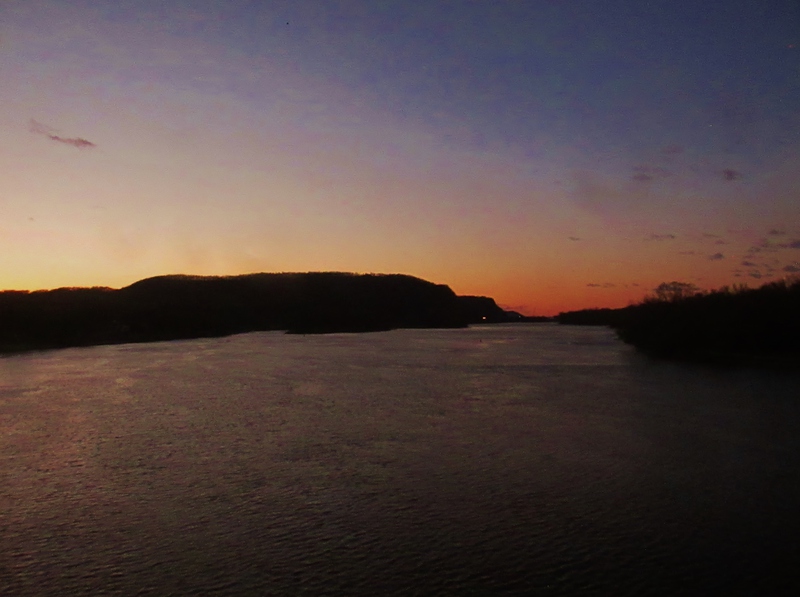 Crossing the Mississippi at nightfall
Crossing the Mississippi at nightfall
As we continued northwest into southeastern Minnesota, I headed down to the lower level of the lounge car where a small café and a few tables are located. It was time for the first beer of the trip! In addition to the usual variety of uninspiring American pilsners, Amtrak also offers a couple of decent American microbrews. Truth be known, Sam Adams and Sierra Nevada Brewing Company have grown large enough over the years that they can no longer truly be called microbrews but their Boston Lager and Pale Ale respectively taste vastly superior to anything put out by either Anhauser Busch or Miller Brewing Company.
Earlier in the afternoon I had made reservations with the Dining Car steward for the 6:30pm dinner seating. Dinner is by reservation only on all of Amtrak’s long distance trains. Typically three or four seatings are offered, ranging from as early as 5:30pm to as late as 7:30pm. Walk-ins are available after about 7:30. I generally like to eat in the middle of the pack as most everything is still available and besides, 6:30pm is pretty close to when I eat dinner at home.
Because the ratio of hungry passengers to available dining car seats is too high to allow for private tables, communal seating is the rule. People are generally seated with whoever shows up just before or after them, so it’s quite possible that you’ll end up with a diverse and occasionally colorful collection of tablemates. For my part I rather enjoy this aspect of traveling on Amtrak because it’s a great opportunity to meet some interesting people and hear their stories. As for myself – well, I’ve been to all 50 states many times over so with my fellow Americans I often share a point of reference and the conversation flows from there. Amtrak is also a great way for visitors from overseas to see America, so it’s always fun to meet these people and hear their perspective on where they’ve been and what they’ve seen.
My dinner companions tonight were a woman and her daughter who had just boarded the train in Milwaukee and were headed for Great Falls, Montana where they lived. They had gone to Wisconsin to attend the wedding of a family friend. Amtrak doesn’t serve Great Falls so they were getting off in Havre where they’d be met and driven the 110 miles down to Great Falls. Interestingly they’d originally purchased round trip tickets in coach but after meeting some sleeper car passengers on the trip out to Milwaukee and hearing about how much nicer it was to lie down at night and have all their meals included in the fare, they decided to upgrade to a roomette for the trip home.
The food on Amtrak’s long distance trains is good but hardly gourmet. Amtrak standardized its menu a couple of years ago in a cost cutting move and while the menu is not extensive it includes enough variety to satisfy the tastes of most reasonable people. Main courses always include a steak, chicken, vegetarian pasta and seafood or fish entrée. The only variant is a chef’s special which is usually a meat oriented dish. All entrees come with rice or a choice of baked or mashed potato and a side vegetable. A side salad is available for $3.00. Salads used to be included with the entrées but they were very basic – just a small bowl of head lettuce accented with a cherry tomato and maybe some shredded carrots now and then. The new $3.00 salads are larger and include onions, tomatoes, carrots and sometimes even a slice or two of green pepper.
You can click
HERE to see a copy of the menu.
Sleeper car passengers may order whatever they like off the menu including sides and dessert. The only thing not included in the fare is alcohol. I ordered the Flatiron Steak and was generally pleased. I asked for medium rare and was presented a steak that was perfectly pinkish-red in the middle. The baked potato was nicely cooked and the side vegetables – a medley of steamed green beans, carrots and cauliflower - were acceptable. I passed on dessert knowing there’d be plenty of opportunities to indulge in the days ahead.
From Wisconsin the
Empire Builder continues through southeastern Minnesota at speeds averaging 70 mph. While this might seem terribly slow to those accustomed to riding European or Asian trains, it’s a speed that is well suited to sightseeing along the way. As one who’s always placed greater value on natural rather than manmade attractions, I consider the ability to see the country up close a major selling point of rail travel, so I’m totally cool with cruising sedately along at 70 mph (110 kmh).
It was nearly dark when we crossed the Mississippi at Hastings. By then I was in the lounge car enjoying an after dinner glass of Jack Daniels on the rocks. Sleeper car passengers are allowed to bring their own liquor onboard, but only for consumption in their private compartments. I suppose I could have done that but then I’d be sitting there drinking all alone. Not my style. Often in the lounge car you get to chatting with one or more people and sometimes a drink or two is involved. I’d rather share a drink or two with fellow passengers discreetly from my $24.00 bottle than buy single airline style minis at $7.00 each plus tip.
As it turned out, by the time I headed back to the lounge car the scene was pretty quiet. This train was about two-thirds full and only a handful of people were upstairs in the lounge car, all of them engrossed in their own activities such as reading, listening to music or watching a movie. A family of four was playing a board game at one of the buffet tables and at another table a girl appeared to be working on her college assignment with books and papers spread out all over the table top. I could hear voices downstairs in the café but of course if you’re planning to illegally pour your own beverage, it’s probably best to stay well away from the bartender.
While I enjoy company, I don’t require it at all times and as such would never dream of foisting myself upon anyone just for the sake of a little socializing. Since I’d already arrived with a glass of ice from the dining car, I took a seat at an empty table, poured myself a healthy slug of JD and fired up my laptop. All of the buffet tables in the lounge are equipped with electrical outlets. Although no Wi-Fi is available on most of Amtrak’s long distance trains, I’ve got plenty of things to entertain me in my laptop.
It was approaching 10pm when an announcement was made that we’d soon be arriving at the Union Depot in St. Paul, Minnesota. This is the first service stop for the westbound
Empire Builder, which means we’ll be here for about fifteen minutes while trash is emptied, food and ice are re-stocked and fuel is taken on. For smokers it’s an excellent opportunity to dash off the train and attend to their addictions. Smoke breaks can be few and often far between on Amtrak trains, so it’s not uncommon to find smokers clustered downstairs by the doorway as we pull into the station – poised and ready to leap off the train with cigarettes out and lighters in hand.
Shortly after departing St. Paul I decided to call it a night. Back in my car I arrived to find that Ray had already made up my room for the night. A fresh bottle of water had been thoughtfully left by the bed while the nightlight shone gently from above. I read for about 45 minutes before extinguishing the lights and slipping off into slumber.
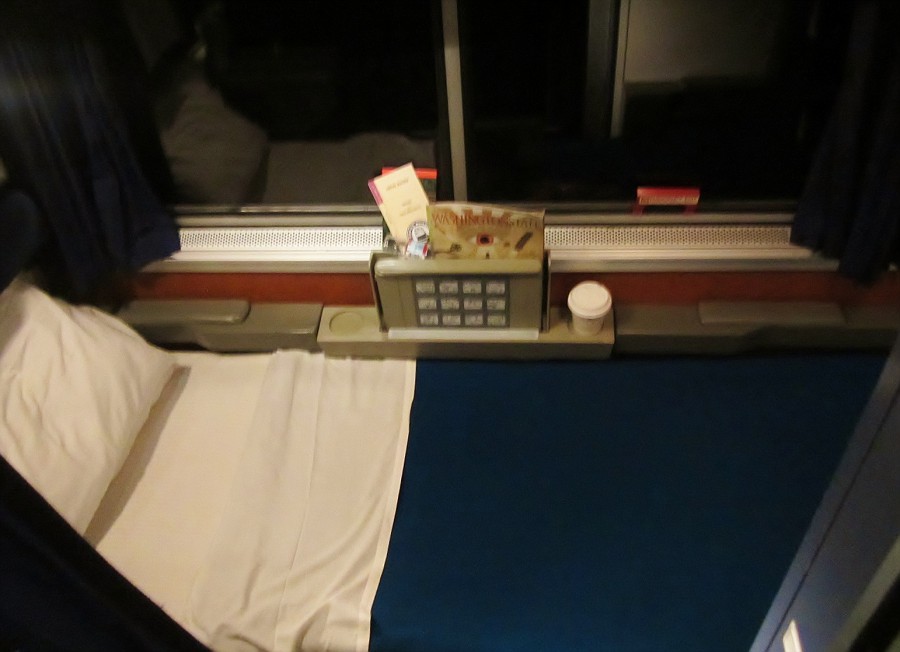 Nighttime configuration of Amtrak’s Superliner Roomette
DAY TWO
Nighttime configuration of Amtrak’s Superliner Roomette
DAY TWO
I awoke to sunshine, blue skies and the rolling plains of central North Dakota. Here and there small patches of wetlands could be seen, populated with a colorful variety of geese, ducks and other birds. We were cruising along at a pretty good pace – the maximum allowable speed for most Amtrak trains is 79 mph – and I thought it was just about the perfect speed to enjoy a landscape such as this. The high Plains are surprisingly pretty under a blue sky. The contrasts of beige, yellow, brown and blue worked very well for me. I paused to take a picture…
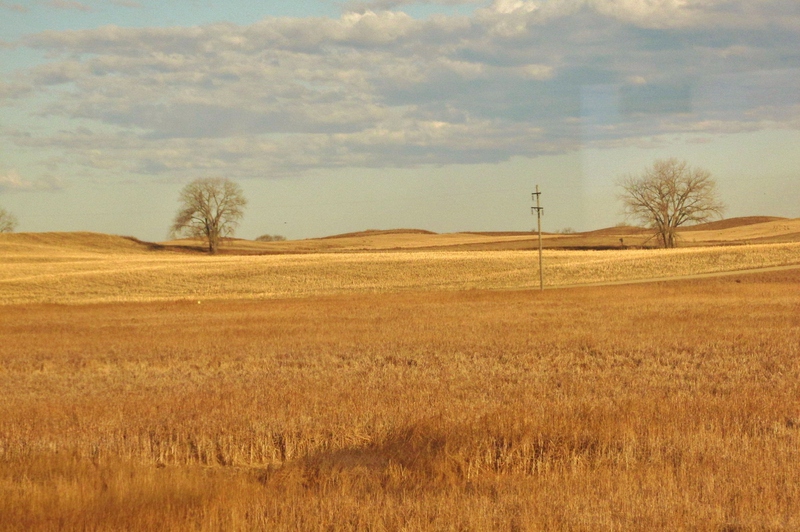 High Plains of North Dakota
High Plains of North Dakota
Following a good hot shower, I made my way up to the diner for breakfast. It was quite a trek! As I mentioned earlier, this train splits into two sections at Spokane – one going to Seattle and one going to Portland. The Portland section is comprised of four cars – the lounge, two coaches and a single sleeper. It’s positioned at the end of the Seattle section which is comprised of two coaches, a diner and two sleepers. Later tonight in Spokane the Portland section will be detached from the main consist, a locomotive will be attached and off we will go down the Columbia River and on into Portland. More on that later though...
The single Portland bound sleeper is the very last car on this train. To get to the diner I had to pass through two Portland bound coaches, the Sightseer lounge car and two Seattle bound coaches before finally reaching the diner. By Amtrak standards this is quite a long walk! On all its other trains – none of which split – the diner is always located right next to the sleepers. In this way the dining room staff will know that if you enter the diner from one direction, your meals are complimentary. From the other direction you’ll have to pay.
Speaking of long walks aboard trains, the longest walks I ever experienced aboard a train was when I was a kid riding aboard Mexican trains back in the seventies. We used to get on in Mexicali and ride down to Empalme or Guadalajara aboard trains that were often 15-20 cars long. As sleeping car passengers we had the run of the train and it was fun to go out and explore. The Mexican trains of those days offered everything from First Class sleepers with lounges to decrepit old coaches with straight back school bus style seats. A few years ago I had some of my old slides digitalized. Here’s an old picture from one of my trips aboard a Mexican train…
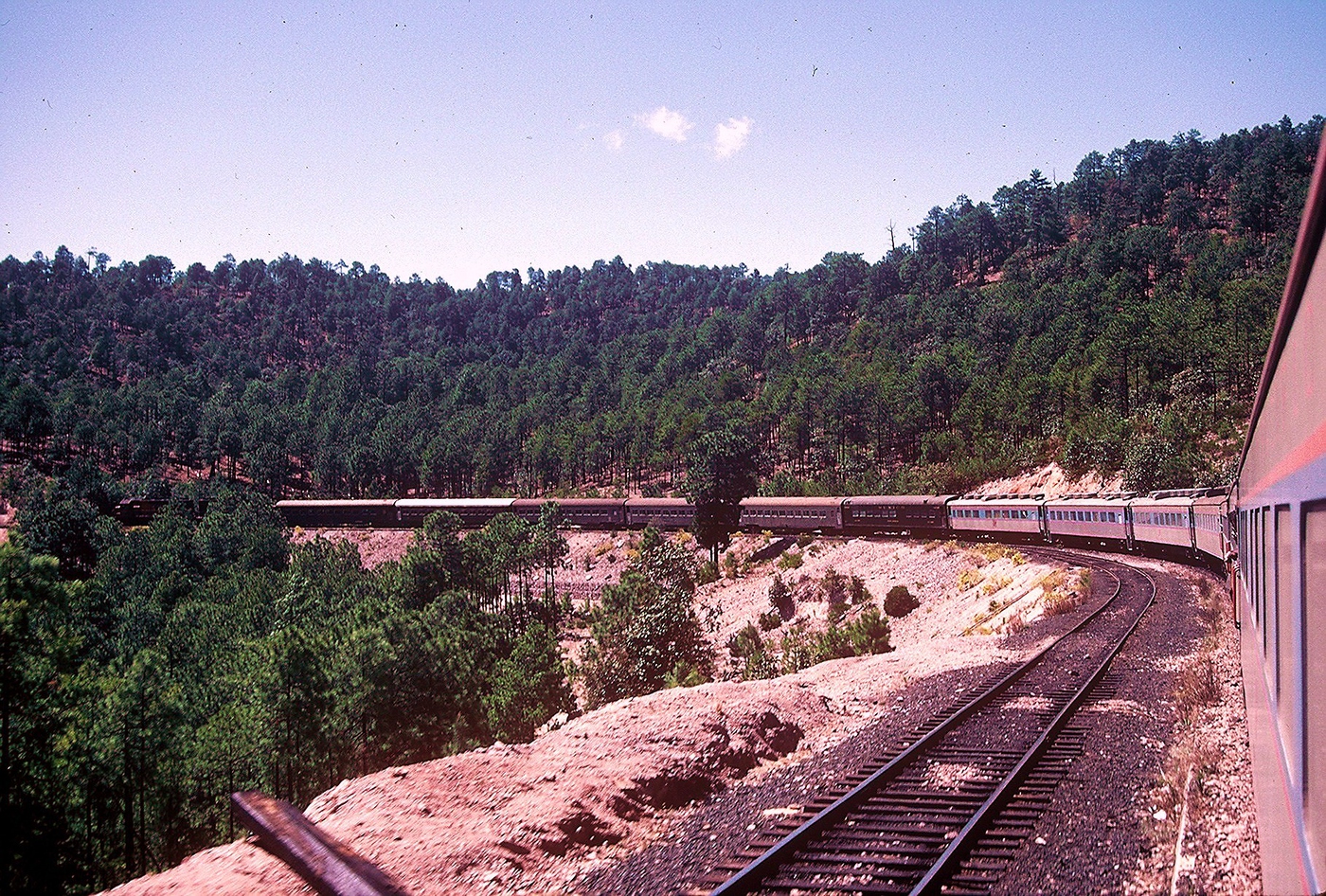 Ferrocarriles del Pacifico
Ferrocarriles del Pacifico
Interestingly, the longest train I ever rode on was in Australia aboard the famous
Ghan. That train was thirty-four cars long! Unfortunately I was traveling in Red Kangaroo class – or economy class if you will – and our movement was limited to two coaches, a café car and a lounge. I took the two pictures below while standing at the station in Darwin…
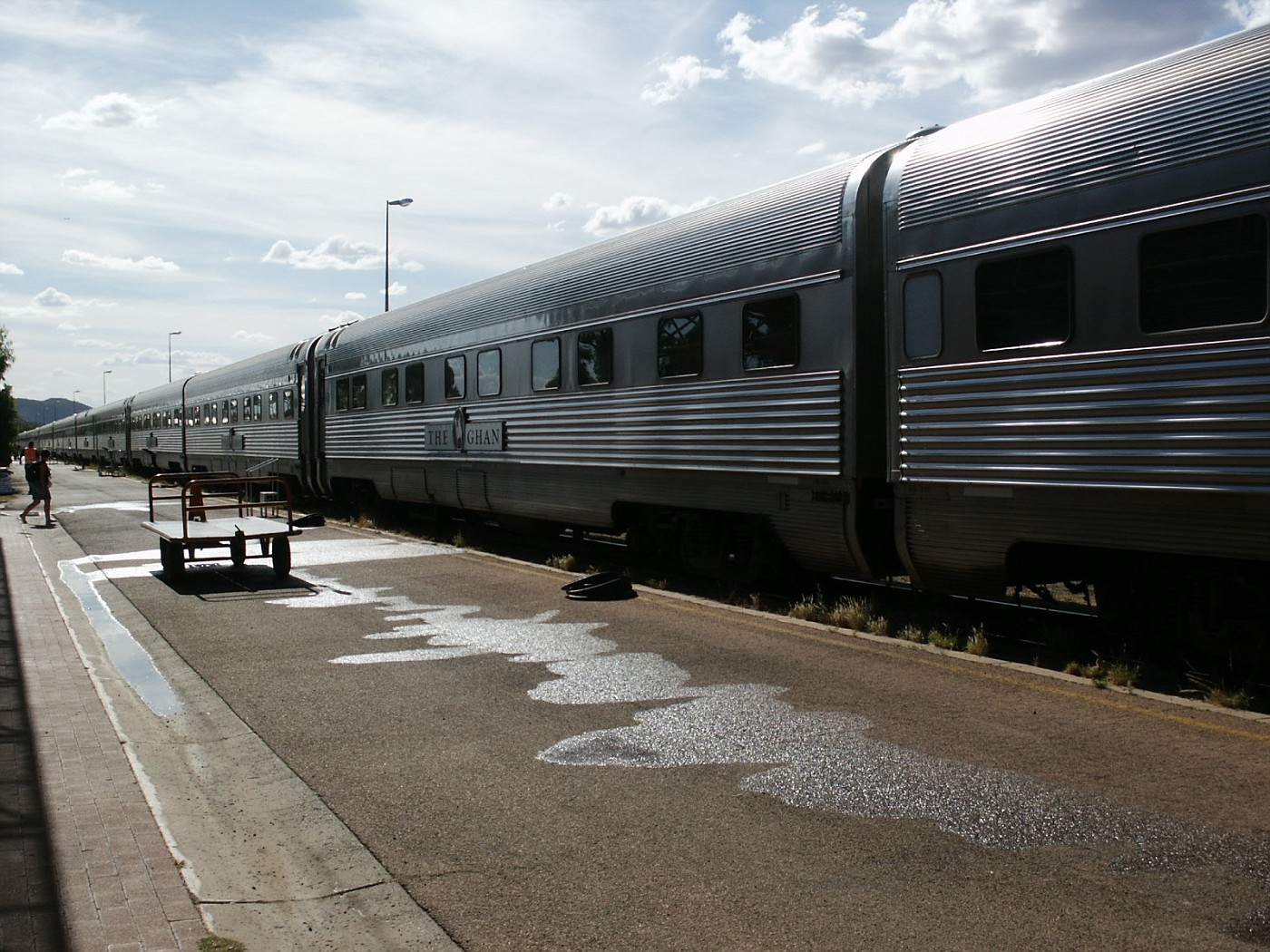 The Ghan – Looking left
The Ghan – Looking left
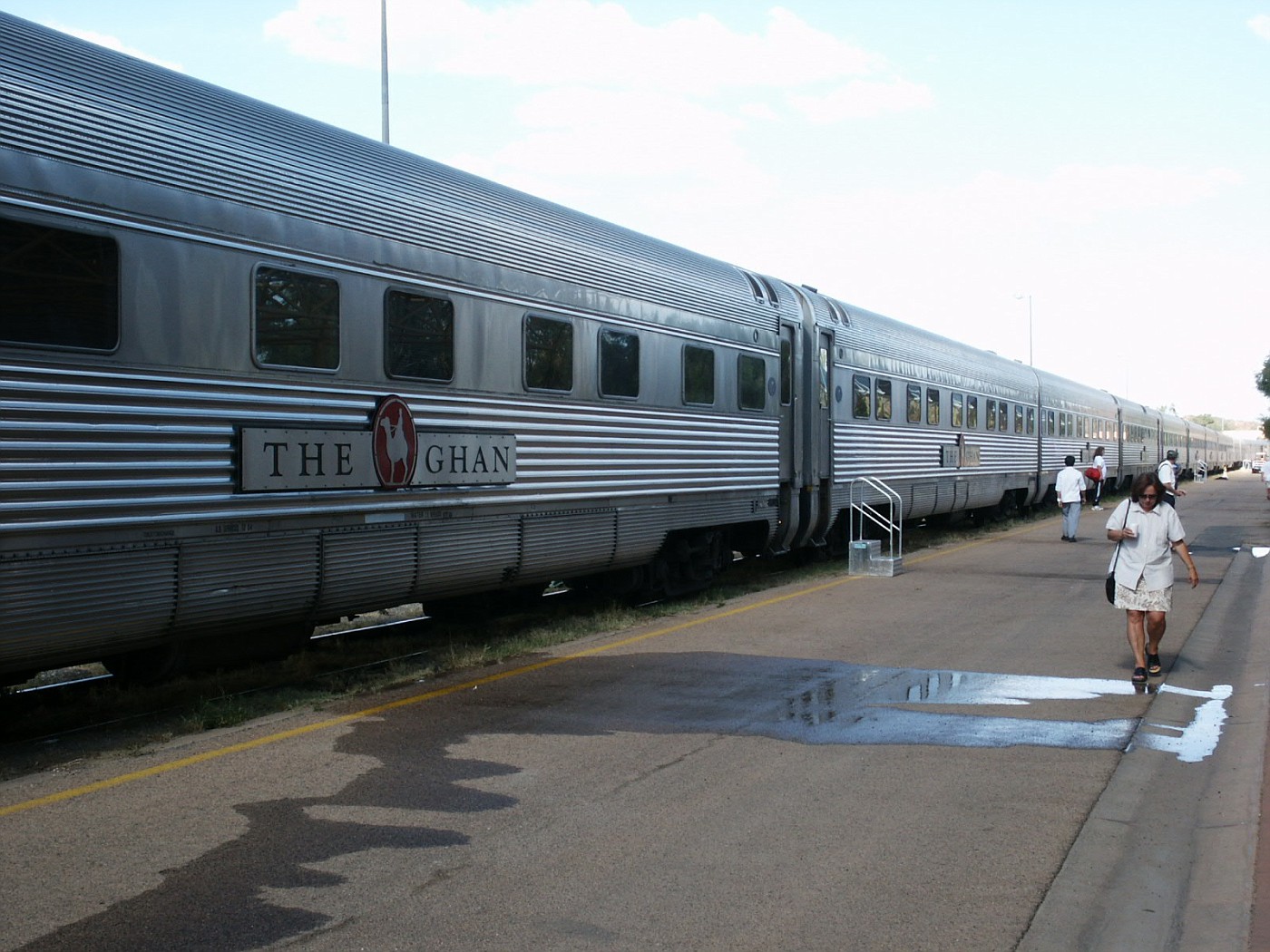 The Ghan – Looking right
The Ghan – Looking right
But enough reminiscing. Let’s go get some breakfast!
My table companions this morning were a man from Kalispell returning home from a USA Railpass trip and two ladies headed to Minot from Minneapolis. We introduced ourselves and then opened our menus to consider the breakfast options. As we did so, our waiter delivered coffee and juice.
 Breakfast in North Dakota at 79 mph
Breakfast in North Dakota at 79 mph
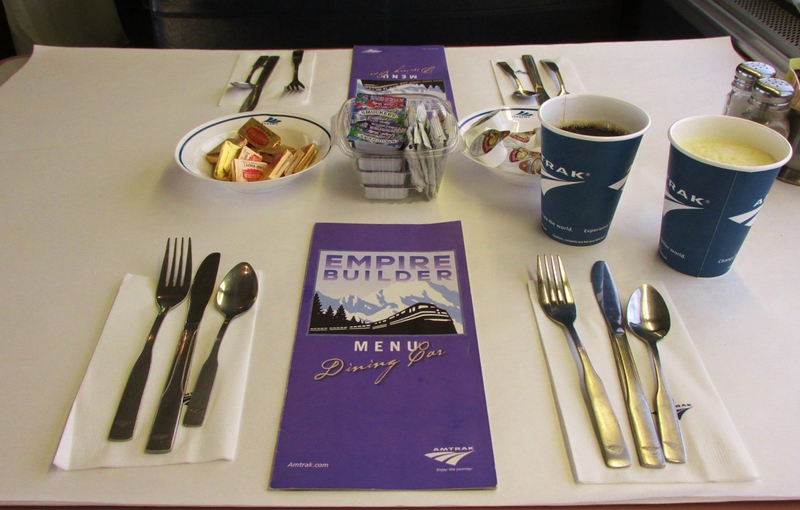 Empire Builder breakfast table setting
Empire Builder breakfast table setting
I described my penchant for photographing the setting and the meal by explaining that I had a young friend back home who was fascinated by trains – especially riding on trains - and so I promised to do my best to record this journey photographically. Of course I just make this stuff up as I go, and the explanation that I provided is a lot easier for most people to digest than the reality of it which is that here I am – a full grown man – taking pictures of the place setting and the meal.
That’s just weird!
Yeah, yeah, whatever… Honestly, I’m at a point in life – and have been for some time – where I don’t particularly care if people see me as strange because of innocuous activities like sleeping in airports or photographing food. The reason I give out explanations such as today’s is because it saves time. Instead of having to answer questions like “But why?” in which case the answer can often spiral off into life history and travels, it’s a lot easier to give people an answer that leaves them thinking “Well isn’t that nice.”. Then we can quickly move on to more entertaining subjects, like our current travels.
Howard returned to take our orders. He comes across as a bit of a surly old guy but I think he’s just being efficient in the best way he knows how. He’s got a lot of people to serve and he doesn’t have time for idle chit chat. Some servers do. One of the ladies commented on Howard’s demeanor and we all had a laugh at the idea of Howard embellishing any of the entrées, as in “We have a lovely vegetable omelette today…” Even though he was not overtly pleasant, he wasn’t rude either. The bottom line for me is he took our orders and served our meals in a timely fashion, and he was good about keeping our coffees topped off. Good job, Howard!
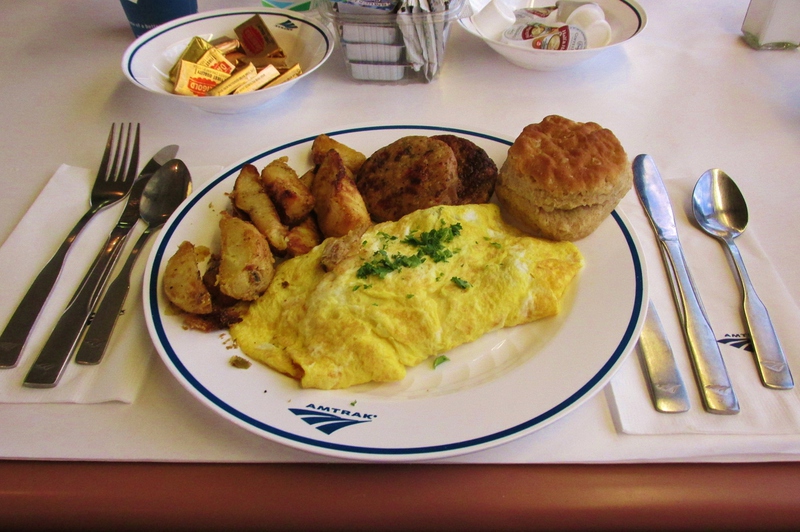 Vegetable Omelette with roasted potatoes and chicken sausage
Vegetable Omelette with roasted potatoes and chicken sausage
In past reports I have published, some people have commented upon what they perceived to be poor quality food on Amtrak. I got the sense that most of these observations were issued from a vegetarian perspective. To be sure, vegetarian choices have rarely been the highlight of Amtrak’s menus but there is always some kind of a vegetarian option offered for each meal. Others are looking for healthier or low calorie options. As with vegetarian options, some low fat or lighter choices are also available for each meal.
Consider my breakfast today. As an alternative to bacon or pork sausage, the chicken sausage I accompanied my veggie omelette with was listed as having only 100 calories. I’ve no doubt I could have also requested less or even no cheese in my omelette. I did not butter my biscuit.
Anyone hoping to find a vegetarian oriented or predominantly low fat/low carb menu designed by some healthy hippies over at the Solar Winds Cooperative Café will of course be a bit disappointed, but I do believe most folks find Amtrak’s menu acceptable given the unique constraints of the dining environment. In terms of overall quality, I would rate the food as being on par with a Denny’s Restaurant. It’s not a gourmet experience, nor is it advertised to be.
* * * _ * _ * * *
After breakfast I returned to my roomette briefly to retrieve my daypack and laptop. With a full day of travel rolling across the Great Plains of North America, now seemed like a good time to take a seat at a table in the lounge car and put in some work on this report.
My car attendant Ray had already returned my roomette to its daytime configuration and was now working on my neighbors’ room. We got to chatting a bit and I asked him how long he’d been working for Amtrak. Like most car attendants, he’d accrued a quite a bit of seniority.
Ray got his start as a coach car attendant back in 1988. After fifteen long years of working the coach cars, he finally graduated to working the sleepers. I’m not sure if congratulations are in order because working the sleepers is a heck of a lot more intensive than working the coaches. Ray is responsible for the needs of up to forty passengers spread out amongst four different types of rooms. Those needs start with meeting and greeting them as they board the train, helping with luggage, making beds at night, breaking down beds in the morning, keeping the shower and toilets clean throughout the trip, delivering meals to rooms upon request and finally helping passengers off the train with their luggage. Somewhere amidst all of that he’s got to find time to eat and sleep.
We were running about five minutes early as we pulled into Minot at 8:25am. Amtrak trains aren’t allowed to leave early, so that meant an extra five minutes we’d have to mill around out on the platform. Smokers rejoiced as they now had enough time to smoke not one but
two cigarettes! It was a beautiful sunny morning and judging by the crowds both trackside and in the comfortable little depot, I got the sense that the daily arrival of the
Empire Builder was a big deal. Minot does have an airport that can handle aircraft as large as 757s but for regional travel – especially into western North Dakota and Montana – the
Empire Builder offers convenient schedules and affordable fares.
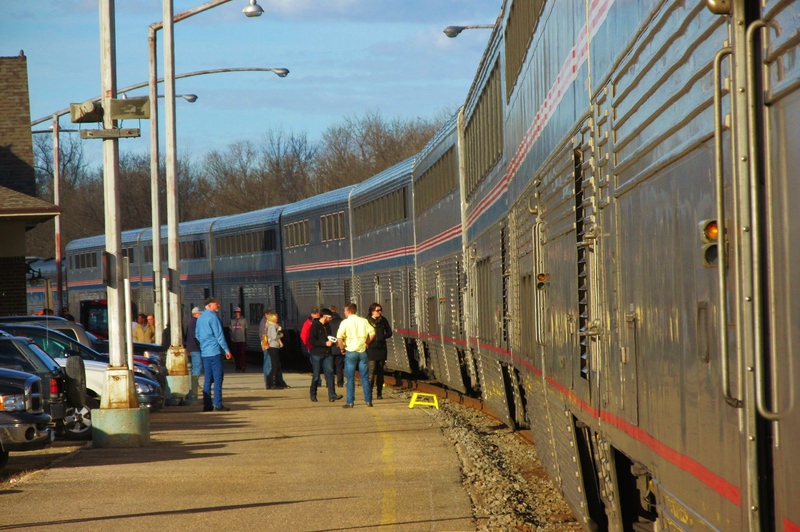 Train time in Minot, North Dakota
Train time in Minot, North Dakota
The 2006 discovery of the Parshall Oil Field outside Williston, North Dakota combined with the ability to economically extract oil via horizontal drilling and hydraulic fracturing led to a significant increase in the number of crude oil and grain trains using the BNSF tracks in Montana and North Dakota. The resulting congestion contributed to horrendous delays for the
Empire Builder, with the train receiving a paltry 44.5% on-time record for November 2013, the worst rating on the Amtrak network. In some cases, the delays resulted in an imbalance of crew and equipment, forcing Amtrak to cancel some runs of the train. In May 2014, only 26% of
Empire Builder trains arrived within 30 minutes of their scheduled time, with delays averaging between 3 and 5 hours. As a result, Amtrak officially changed the scheduled times for station stops west of Minneapolis, changes which took effect on April 15, 2014. I had really looked forward to riding the
Empire Builder during this time as it would have allowed me to see during daylight hours some of the pretty mountainous country west of Spokane. Unfortunately – or fortunately depending upon your perspective – Amtrak was recently able to work things out with the BNSF (Burlington Northern Santa Fe to all you air travelers out there) so that the
Empire Builder was able to return to its traditional schedule.
For me one of the real attractions of train travel across America is a chance to meet the locals and through interaction with them gain a better understanding and appreciate the land and communities you’re traveling through. By contrast, on an airplane these days your window shade would likely be down, your ears covered in the latest noise cancelling Bose headphones and your attention drawn to the screen in front of you as you watched actors portraying roles of people and lifestyles far different from the lives of the people who live 35000 feet below you.
At lunch I was seated across from Bert and Marie, an older couple originally from Williston but now living in Minot. Bert made an interesting point about how with the boom, everything in Williston became more expensive - from real estate to food. Many people who had lived there a long time could hardly afford to live there anymore. Marie was thankful that they’d moved to Minot fifteen years earlier. Some of their friends still in Williston not only couldn’t afford to live there, they couldn’t afford to move away from there either!
I noticed that very few people on this train were traveling the full distance between Chicago and the Pacific Northwest. There was lots of local traffic between Chicago/Milwaukee and Minneapolis as well as between towns in the North Dakota and Montana region.
In the land around Williston there are limestone rock formations more typical of the Badlands of South Dakota than the prairies of North Dakota. As we continued west into eastern Montana the terrain became ever more hilly, offset by shallow gulches and even the occasional mini-gorge. Ever so gradually rolling plains transitioned into low hills and buttes. You could sense the excitement of thru-passengers as the promise of travel through the Rocky Mountains was soon to be realized.
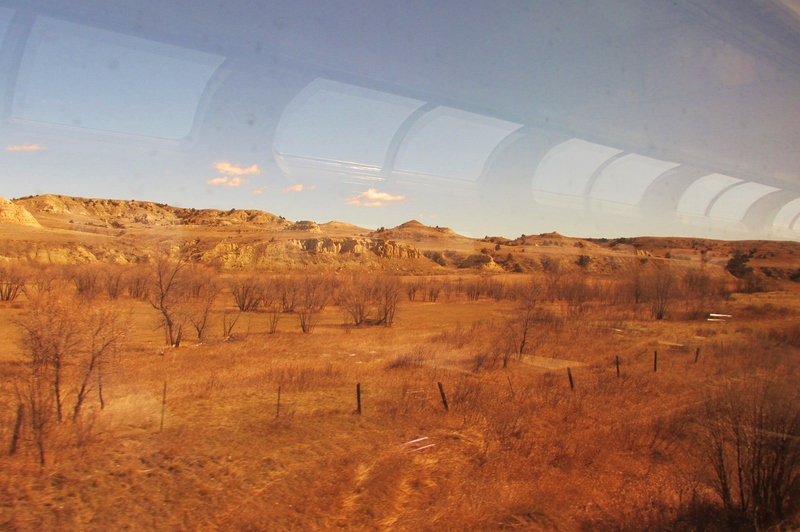 Low hills and buttes of eastern Montana
Low hills and buttes of eastern Montana
One thing I noticed as we sped through eastern Montana was a distinct lack of trees. Occasionally one or two cottonwoods would show up around an old farmhouse or a town but otherwise the land was barren.
It was 2:35pm when we pulled into Havre, Montana. Sitting at the approximate halfway point between Minneapolis and Seattle, Havre was founded primarily to be a service center for the Great Northern Railway. Up until the 1990s, the railroad was the primary employer in town and Havre remains a service center for the BNSF to this day. As such, we stopped first to take on fuel and then proceeded another 150 yards on to the large brick station building.
Back in the 1980s, Amtrak used to offer a great deal called the All Aboard America Pass. The contiguous United States was divided into three sections and you could by a pass through any one or all of them for $125.00 per section. There was a period in 1984 where I spent the better part of a month and a half riding just about every long distance train in the Amtrak system, as well as many shorter routes. It was all about travel and seeing America and I accomplished that and then some.
Over the years I reckon I bought at least a dozen All Aboard America passes, most of them in the western two thirds of the country. For the western zone, the easternmost town served on the
Empire Builder route was Wolf Point, Montana. On those occasions where I had only a western zone pass, it made better sense to only go as far as Havre because the schedules were such that the eastbound
Empire Builder arrived in Havre at about noon and the westbound train came through at about three. It was the perfect layover with plenty of time to head into town for lunch and even a visit to Havre’s famous underground mall.
As a thru-passenger today I had about twenty minutes to step off the train for a bit of fresh air. I took a stroll down to the far end of the station to check out the huge Baldwin S-2 Class “Northern” steam locomotive. It is a massive machine, weighing in at over 400,000 pounds. Combined with the oil tender attached behind, its overall length was about the same as a 737-200. It’s the last surviving unit of its type and though it’s looking pretty good I thought it could really use a new coat of paint.
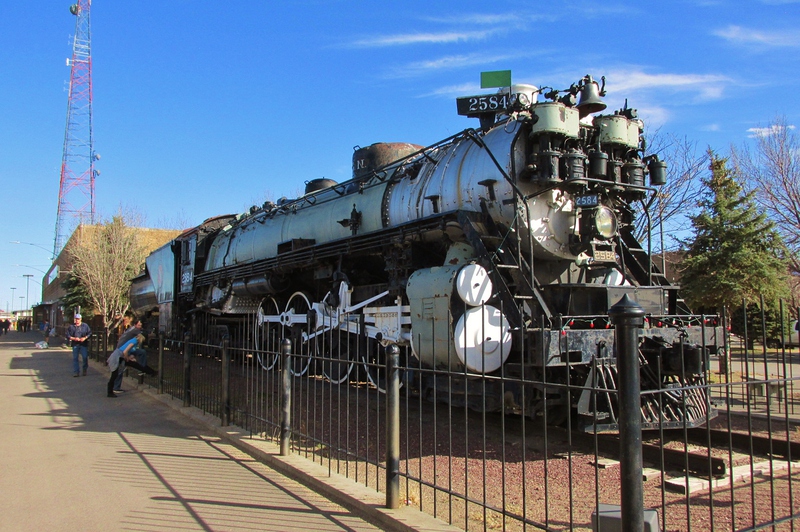 The Baldwin S-2 Class “Northern” steam locomotive at Havre
The Baldwin S-2 Class “Northern” steam locomotive at Havre
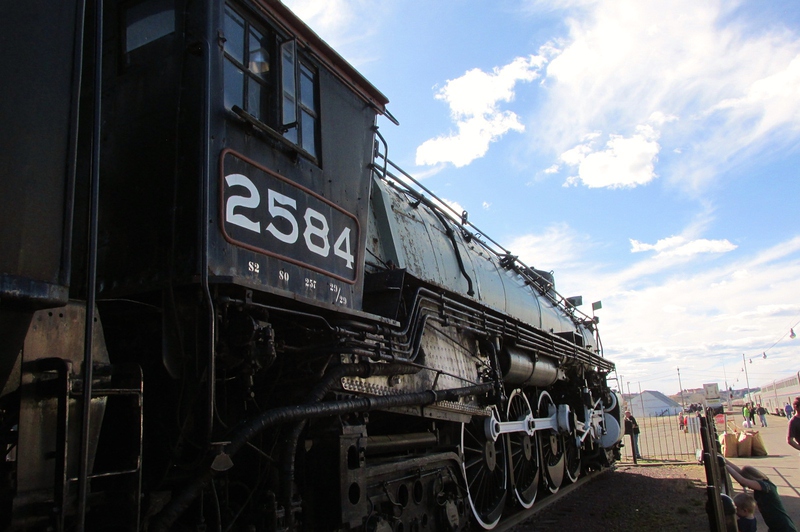 The Baldwin S-2 Class “Northern” steam locomotive at Havre
The Baldwin S-2 Class “Northern” steam locomotive at Havre
Departing Havre we quickly accelerated to 79 mph as we sped westward across the broad expanse of Montana’s High Plains. Distant mountains rose to the south. Some antelope were spotted a couple hundred yards off the tracks. They looked up, registered the noise from the engines and quickly took off running – just in case our train should leap off the tracks and give pursuit.
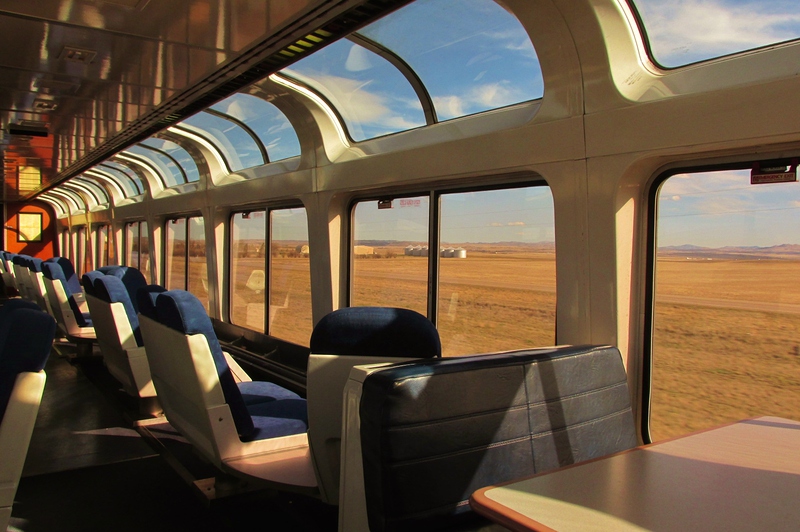 Speeding across the High Plains of Montana
Speeding across the High Plains of Montana
It was about 4:00pm when I decided to return to my roomette and stretch out for a bit. I’ve got a bad back and it’s not good to sit for too long. Just as many of you have enjoyed the luxury of deeper recline in a First or Business Class seat on a long intercontinental flight, Amtrak’s Superliner roomettes will quickly and easily convert to full flat mode. It’s so easy I did it all by myself without any assistance from Ray. Ah…
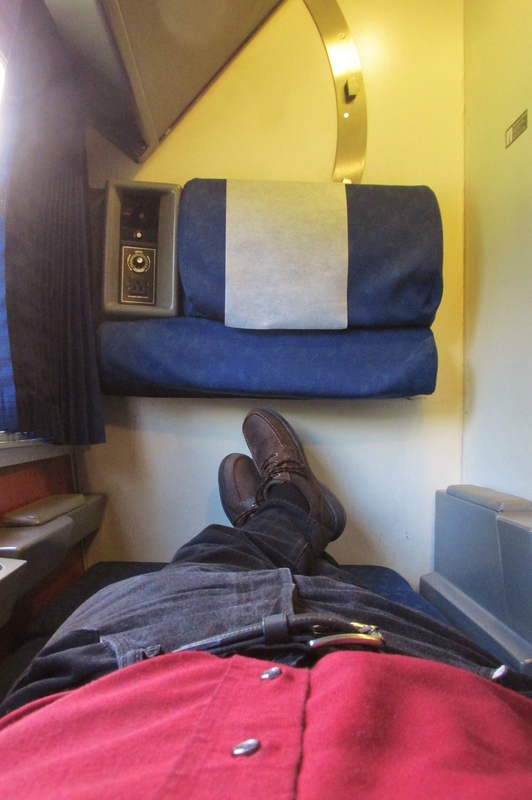 Stretching out across the High Plains of Montana
Stretching out across the High Plains of Montana
If there could be said to be a downside to riding westbound on the
Empire Builder at this time of year, it would be that it’s nearly dark by the time the train reaches the eastern boundary of Glacier National Park outside of Browning, Montana. Although I’ve made this crossing many times during the longer days of June and July, I still look forward to revisiting the spectacular beauty of the park’s mountains, valleys, rivers and lakes. Alas, tonight it was not to be as darkness had set in by the time we’d rolled through Browning.
My dinner companions tonight were Kate and her 12 year old son Simon, my neighbors from downstairs in the roomette across the hall. Like me they had boarded in Chicago and were traveling all the way to Portland. Like me, they also lived in Alaska – albeit 600 miles to the south down in Homer. Even so, we just happened to know some of the same people – one of whom used to work in Denali Park with me and two others who own and operate the Homer Brewing Company. We ended up with a table to ourselves and needless to say the conversation percolated along quite nicely. It turns out young Simon was a stamp collector and - given my upcoming travels to South America and South Africa – I got his address and promised to send him a couple of postcards.
 BEEF – It’s what’s for dinner when traveling through Montana
BEEF – It’s what’s for dinner when traveling through Montana
Later in the lounge I shared most of what was left of my bottle of Jack Daniels with Jim who worked as a carpenter in and around Kalispell, Montana. Where we connected was that back in the nineties Jim had worked three summers in Glacier National Park as a “Jammer” or driver of the old 1936 White touring cars that transport park visitors up Going to the Sun Road over Logan Pass. As some of you may know by now, I also drive visitors over mountain passes in a national park…
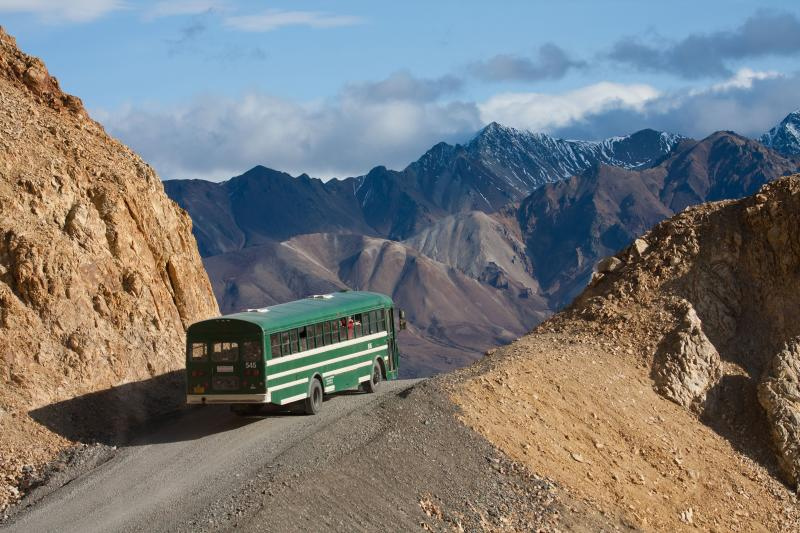 My Office in Denali National Park
My Office in Denali National Park
Jim made an interesting point when he stated that only in Glacier National Park can you still take a passenger train that's run for over three quarters of a century directly to the park, board buses that have been around almost as long as the train, and then stay at hotels and lodges still in use and built by the railroad that helped create the park nearly a century ago. We had a good time talking about the West in general until Jim detrained at Whitefish, Montana. I hung out in the lounge car for another hour or so and then called it a night just as we were about to cross into Idaho.
I was asleep by the time we arrived in Spokane at 1:40am. The train spent about an hour there during which time the lounge and the three Portland bound cars were separated to continue southwest along the Columbia River on the former Spokane, Portland and Seattle Railroad. The rest of the train ahead of the lounge car would continue west through the Cascades Range and across Stevens Pass via the Cascade Tunnel to Seattle.
Despite the bumps and jolts attendant to separating the four Portland bound cars from the rest of the train, I never did wake up. By the time I finally did, the sun was just getting ready to rise over the broad expanse of the Columbia River as we sped west out of Wishram, Washington with Portland now less than three hours away.
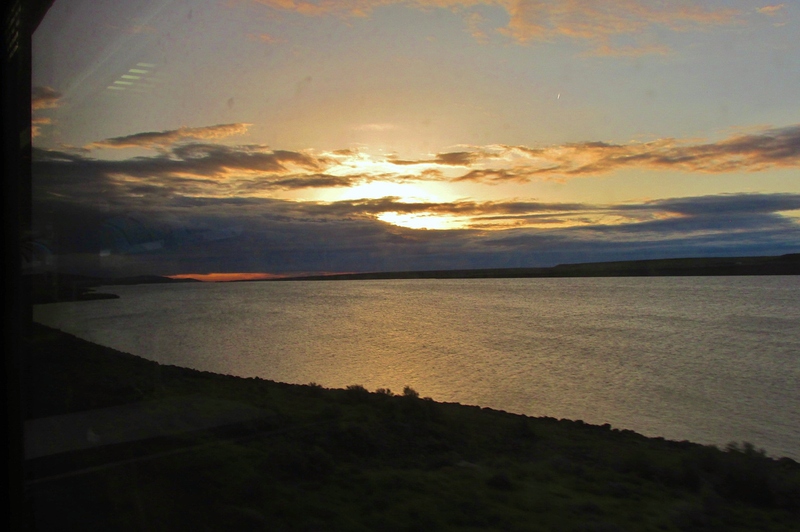 Sunrise over the Columbia River
Sunrise over the Columbia River
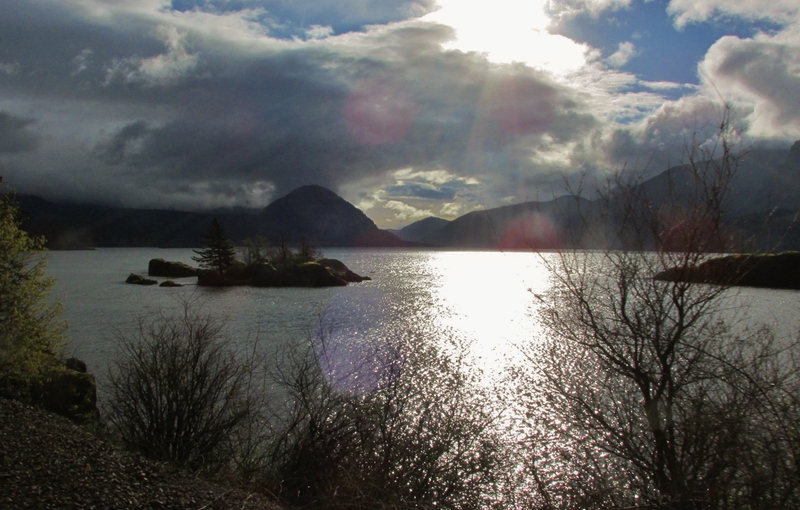 Early morning sunlight sparkles on the Columbia
Early morning sunlight sparkles on the Columbia
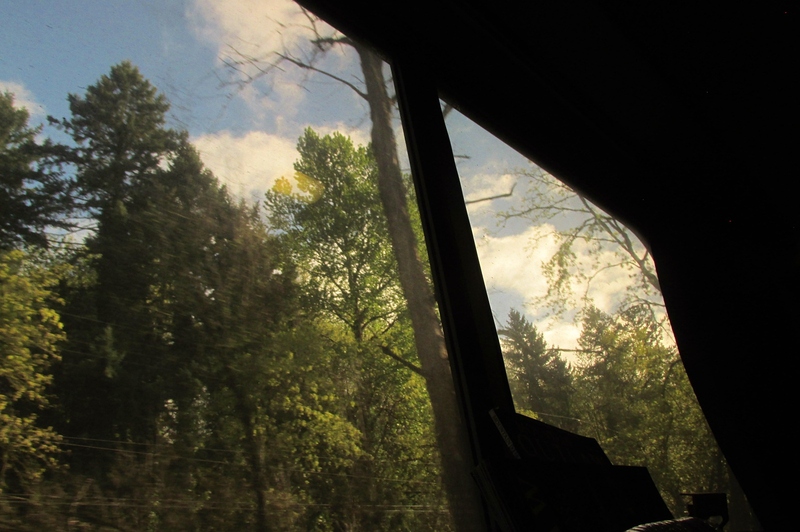 Stretched out in my sleeper as we roll through the forest outside Vancouver, WA
Stretched out in my sleeper as we roll through the forest outside Vancouver, WA